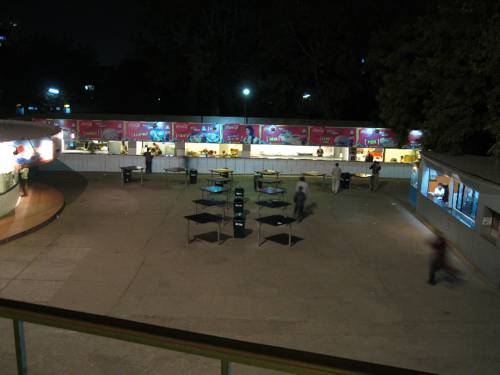
FAQ About The Impact of Food in Global Cinematic Narratives

How does food play a role in cinematic storytelling across different cultures?
Food in films acts as a powerful narrative device that can reveal much about a culture’s identity, values, and social norms. In different cultures, food is used to symbolize tradition, convey emotions, and create connections between characters. For example, in Italian cinema, pasta might be used to highlight themes of family unity, whereas in Japanese films, a sushi-making scene may represent precision and dedication to craft.

Can you give examples of films where food shapes the narrative?
Several films are known for their significant use of food to drive the narrative. 'Ratatouille' showcases a rat’s journey to becoming a chef, emphasizing themes of passion and perseverance through cooking. 'Eat Drink Man Woman' by Ang Lee beautifully explores family dynamics in Taiwanese culture through elaborate dinner scenes. Similarly, 'Julie & Julia' intertwines two women's stories via their cooking and culinary challenges, underscoring personal growth and resilience.

Why is food important in films about cultural identity?
Food is deeply ingrained in cultural identity and serves as an effective visual cue in films to express cultural traditions and familial ties. It conveys a sense of place and history, providing audiences with a deeper understanding of the characters and their backgrounds. Films can leverage food to challenge stereotypes or celebrate the uniqueness of a culture, making it an integral tool for storytelling.

How do filmmakers use food to convey emotions in movies?
Filmmakers use food scenes to express emotions such as love, nostalgia, and tension. The preparation and sharing of meals can symbolize love and care among characters, while loneliness may be depicted through a solitary meal. The act of cooking itself can be shown as therapeutic or stress-inducing, framing the emotional state of a character through culinary interactions.

What are some misconceptions about food in global cinema?
One common misconception is that food is a mere background element rather than an active, meaningful part of storytelling. In reality, food often carries significant symbolic weight, representing themes like power dynamics, social status, and cultural assimilation. Additionally, there is a tendency to generalize culinary portrayal as universal, ignoring the nuanced differences that food culture holds across various societies.

In what ways do food scenes enhance visualization and aesthetics in films?
Food scenes contribute richly to the visual appeal and aesthetic quality of films. The vibrant colors, textures, and movements involved in cooking and eating can create visually stimulating scenes. Carefully choreographed dining sequences or food preparation can captivate audiences and enhance the storytelling by engaging their sensory perceptions. This makes food an indispensable element in terms of film aesthetics.

How does the portrayal of food differ between Western and Eastern films?
Western films often use food to comment on individuality, lifestyle, and personal achievements, while Eastern cinema might incorporate food more intricately with themes of tradition, family, and community. For example, Western films may focus on the art of cooking as a personal journey, whereas Eastern films might portray communal eating to symbolize the harmony between elements of life. However, both regions use food as a bridge to explore complex narrative layers.

What is the significance of food rituals in films?
Food rituals such as family dinners, holiday feasts, and traditional ceremonies are potent storytelling vehicles that convey cultural norms and character relationships. These rituals can be used to depict transitions, mark important events, or highlight tension and conflict. They provide a rich, multi-layered narrative context, offering artists the ability to seamlessly blend everyday life with cinematic themes.

How have modern films evolved in their depiction of food scenes?
Modern films have increasingly integrated food scenes to reflect contemporary issues such as globalization, environmental concerns, and multiculturalism. This evolution has expanded the narrative functions of food in cinema, highlighting not only its traditional cultural values but also its role in modern society. Films now often use food to comment on health trends, eco-sustainability, and cultural exchanges in a globalized world.

What role do food documentaries play in cinema?
Food documentaries are crucial in showcasing culinary traditions, historical food trends, and current issues within food industries. They provide insightful, educational perspectives on the global impact of food, often delving into the socio-political and economic aspects. These films enlighten viewers about different cultural cuisines and the ethics of food production and consumption.

Can food in cinema influence public perceptions and behavior?
Yes, food in cinema can significantly influence public perceptions, shaping attitudes towards different cultures and culinary practices. By exposing audiences to diverse food traditions, films can foster appreciation and understanding, potentially impacting consumer behavior and culinary exploration. Moreover, films highlighting sustainable practices or ethical issues can raise awareness and inspire action among viewers.

How do cultural differences influence the representation of food in films?
Cultural differences profoundly impact how food is depicted in films, with each culture bringing unique culinary traditions and values to the screen. These representations are often tied to cultural norms, religious practices, and historical contexts, shaping how food-related narratives develop in various regions. Understanding these differences enhances the cultural richness and authenticity portrayed in global cinematic narratives.

Are there any films that challenge stereotypes through their depiction of food?
Films like 'The Hundred-Foot Journey' challenge stereotypes by illustrating the coming together of diverse culinary traditions and promoting cultural integration. 'Chef,' directed by Jon Favreau, dismantles the stereotype of food trucks as inferior to traditional dining by presenting gourmet cooking in a mobile setting. These films use food to break down cultural barriers and build new perspectives on traditional culinary archetypes.

What is the role of food metaphors in cinematic narratives?
Food metaphors in cinema serve to symbolize broader themes such as survival, desire, and transformation. For instance, the preparation and consumption of food can represent personal growth or decay, and a banquet might symbolize excess and indulgence, or community and sharing. These metaphors allow filmmakers to convey complex emotions and narratives without explicit dialogue, enriching the viewer's interpretative experience.

How do animation films use food in storytelling?
Animation films creatively use food not only for its narrative value but also for its visual playfulness and appeal. In 'Cloudy with a Chance of Meatballs,' food forms the central spectacle, driving the plot with whimsical, oversized dishes. Animated films often personify food, imbuing it with character-like qualities, which can engage audiences in unique, imaginative storytelling that resonates across age groups.

How does food in films reflect social issues?
Food in films often mirrors social issues such as class inequality, ethical consumption, and cultural clashes. Movies might portray lavish dining by the wealthy against the backdrop of poverty or use food scarcity as a narrative device to highlight socio-economic disparities. By addressing these issues, films encourage audiences to reflect on real-world societal challenges via a relatable medium.

What techniques do filmmakers use to shoot compelling food scenes?
Filmmakers employ various techniques to create appealing food scenes, such as close-ups to highlight textures and colors, slow-motion captures during food preparation, and evocative sound design that enhances the auditory experience of cooking. Lighting and angles are carefully chosen to emphasize the appetizing nature of the food and evoke mood, capturing the essence of culinary art within narrative storytelling.

Can you list some directors known for their use of food in their films?
Directors like Ang Lee, with films such as 'Eat Drink Man Woman,' and Jon Favreau, with 'Chef,' are renowned for their skillful integration of food into film narratives. Gurinder Chadha's 'Bend It Like Beckham' and more recent works like 'The Hundred-Foot Journey' also illustrate how directors use culinary elements to enhance stories, highlighting cultural intersections and identity.

How do films depicting food influence the culinary industry?
Films spotlighting food can drive trends in the culinary industry by popularizing certain dishes, cooking techniques, or food cultures. This influence can increase demand in restaurants, introduce new flavors and styles to different regions, and elevate the status of particular cuisines, contributing to the cultural exchange and culinary diversity evident in contemporary dining scenes.

What impact does globalization have on food representation in films?
Globalization has broadened the scope of food representation in films, encouraging a blend of cuisines and culinary practices in cinematic narratives. This cross-cultural exposure reflects the merging and evolution of food traditions, illustrating the accessibility and variety of global gastronomy. Films often depict hybrid cuisines and diverse culinary landscapes, highlighting themes of multiculturalism and global interconnectedness.
